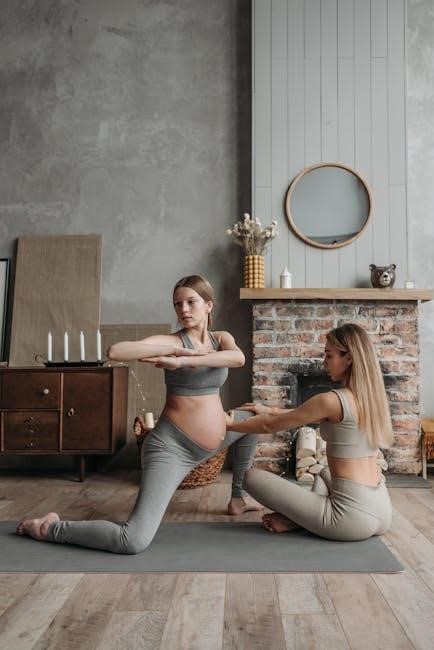Lighting design transforms spaces by balancing functionality, aesthetics, and ambiance; It enhances mood, productivity, and wellbeing through strategic use of light layers and color temperatures, creating inviting and functional environments.
Types of Lighting
Lighting is categorized into three primary types: ambient, task, and accent. Ambient provides overall illumination, task focuses on specific areas, and accent highlights features, ensuring balanced, functional spaces.
2.1 Ambient Lighting
Ambient lighting provides overall illumination, creating a uniform base level of light in a room. It is designed to be soft and diffuse, reducing harsh shadows and glare. Common sources include ceiling fixtures, wall sconces, and natural light. This type of lighting is essential for setting the general atmosphere and ensuring safety and comfort. Proper ambient lighting makes spaces feel welcoming and relaxed, serving as the foundation for other lighting layers. It is particularly important in living areas and bedrooms, where a calm environment is desired. By evenly distributing light, ambient lighting helps to minimize eye strain and creates a balanced visual environment, making it a crucial element in any lighting design.
2.2 Task and Accent Lighting
Task lighting focuses on providing illumination for specific activities, such as reading, cooking, or working. It is typically brighter and more concentrated than ambient light. Examples include under-cabinet kitchen lights, desk lamps, and recessed lighting over workstations. Accent lighting, on the other hand, is used to draw attention to particular features, like artwork or architectural details, by creating a focal point. It often employs directional light sources, such as track lights or spotlights, to highlight objects. Together, task and accent lighting enhance functionality and aesthetics, adding depth and visual interest to a room. Balancing these with ambient light creates a layered lighting scheme that is both practical and visually appealing, ensuring each space is tailored to its purpose while maintaining a cohesive design.

Room-by-Room Lighting Guide
This guide provides tailored tips for lighting each room, ensuring functionality and aesthetics. Kitchens need bright task lighting, while bathrooms require ambient and task lighting. Living rooms benefit from a mix of lighting for relaxation and entertainment, and bedrooms should prioritize soft, warm lighting for comfort. By addressing the unique needs of each space, you can create inviting and functional environments that enhance daily life.
3.1 Kitchen and Bathroom Lighting
Kitchen and bathroom lighting require careful planning to ensure functionality and safety. In kitchens, task lighting is essential over countertops and islands, while ambient lighting provides overall illumination. Use under-cabinet LED strips or pendant lights for focused task areas. Bathrooms need bright, shadow-free lighting, often achieved with LED strips around mirrors or recessed lighting. Consider water-resistant fixtures for durability. Color temperature plays a role—cool whites (5000K-6500K) enhance task efficiency, while warm whites (2700K-3000K) create relaxation. Layering lighting ensures versatility, combining ambient, task, and accent options. Proper placement and fixture selection can elevate both spaces, making them functional, inviting, and safe.
3.2 Living Room and Bedroom Lighting
Living rooms and bedrooms benefit from layered lighting to create cosy, inviting atmospheres. Ambient lighting, such as ceiling fixtures or wall sconces, provides overall illumination. Table lamps or floor lamps add task lighting for reading, while accent lighting highlights decorative elements. In bedrooms, soft, warm lighting enhances relaxation, with options like bedside lamps or recessed lights. Consider dimmers to adjust brightness for different activities. Cool tones can energize, while warm tones promote calm. Balance functionality and style by selecting fixtures that complement room decor. Proper lighting placement and intensity ensure spaces are both functional and aesthetically pleasing, fostering comfort and tranquility in these personal areas.

Factors to Consider When Choosing Lighting
Color temperature, CRI, fixture types, and placement are key. Room size, natural light, and personal style influence decisions. Proper lighting enhances functionality, aesthetics, and ambiance, ensuring spaces feel inviting and well-lit.
4.1 Color Temperature and CRI
Color temperature, measured in Kelvin (K), defines a light’s warmth or coolness. Warm white (2700K-3000K) creates cozy spaces, while cool tones (3500K-5000K) enhance task-oriented areas. Color Rendering Index (CRI) measures how accurately colors appear under a light source, with higher CRI (80-100) being ideal for vibrant color representation. Balancing these factors ensures lighting supports both functionality and aesthetics, making spaces feel inviting and visually appealing. Proper selection enhances mood, productivity, and ambiance, making it crucial for tailored lighting solutions. Understanding these elements helps in choosing lights that align with the desired atmosphere and task requirements of each room.
4.2 Fixture Types and Placement
Choosing the right lighting fixtures and placing them correctly is essential for achieving desired illumination. Fixtures vary widely, from ceiling lights and chandeliers to wall sconces, table lamps, and recessed lighting. Each type serves specific purposes, such as ambient, task, or accent lighting. Placement depends on room size, ceiling height, and functionality. For example, task lighting like under-cabinet kitchen lights should be positioned near work areas, while ambient fixtures like ceiling lights provide overall illumination. Layering light sources enhances functionality and aesthetics. Proper placement avoids glare and ensures even light distribution. Fixtures should complement the room’s decor and layout, creating a harmonious balance between form and function. Strategic placement also highlights architectural features or design elements, making spaces feel cohesive and well-designed. Understanding fixture types and placement is key to creating a lighting scheme that meets both practical and stylistic needs.

Smart Lighting Solutions
Smart lighting enhances convenience and efficiency through automation, voice control, and app-based systems. It integrates seamlessly with smart homes, offering customizable settings and energy-saving features for modern living spaces.
5.1 Smart Bulbs and Automation Systems
Smart bulbs and automation systems revolutionize home lighting by offering voice control, scheduling, and remote access via apps. These systems integrate seamlessly with smart home devices, enabling customizable lighting scenes and energy efficiency. With features like color temperature adjustment and brightness control, smart bulbs enhance ambiance and functionality. Automation systems, such as Philips Hue or Belkin, allow users to program lighting schedules, ensuring convenience and security. Energy-saving capabilities optimize power usage, reducing long-term costs. By incorporating smart lighting, homeowners can create dynamic, adaptive environments that cater to their lifestyle and preferences, making it a cornerstone of modern smart home technology.

Outdoor Lighting
Outdoor lighting enhances safety, curb appeal, and ambiance while illuminating pathways, gardens, and exterior spaces. Energy-efficient LED options and strategic placement ensure functionality and aesthetic appeal for any setting.
6.1 Landscape and Security Lighting
Landscape and security lighting combines functionality and aesthetics to safeguard your property while highlighting its beauty. LED options offer energy efficiency and durability, with solar-powered choices reducing operational costs. Motion sensors enhance security by detecting movement, ensuring areas remain well-lit during unexpected events. Pathway lights guide visitors safely, while accent lights emphasize garden features. Proper placement ensures even illumination, reducing shadows where intruders might hide. Weather-resistant fixtures withstand outdoor conditions, maintaining reliability year-round. This dual-purpose lighting elevates curb appeal and deters potential threats, creating a secure and visually appealing outdoor space. By integrating smart technologies, you can automate lighting schedules, further enhancing security and convenience. Tailoring your lighting design to your landscape ensures both beauty and protection, making it an essential investment for any home. Always consider local regulations and energy efficiency when selecting fixtures.
Emergency Lighting Systems
Emergency lighting systems are critical for ensuring safety during power outages or evacuations. These systems provide reliable illumination for escape routes, exits, and essential areas. They typically include backup power sources, such as batteries, to maintain functionality when primary lighting fails. Exit signs, emergency luminaires, and standby lights are common components, guiding occupants to safety. Regulations often mandate specific brightness levels and durations for emergency lighting. Proper installation, testing, and maintenance are essential to ensure compliance and effectiveness. Modern systems integrate LED technology for energy efficiency and longevity. Smart emergency lighting can also adapt to conditions, such as adjusting brightness based on occupancy. These systems not only meet legal requirements but also provide peace of mind by ensuring visibility and wayfinding in critical situations. Regular inspections are vital to uphold performance and reliability over time. Emergency lighting is a cornerstone of building safety, protecting lives during unexpected events. Always consult professionals for tailored solutions.